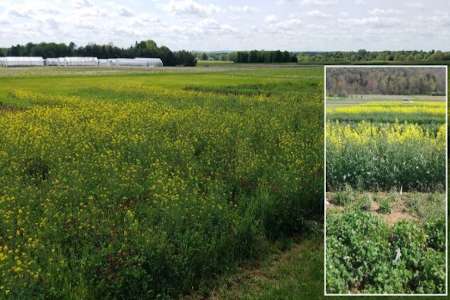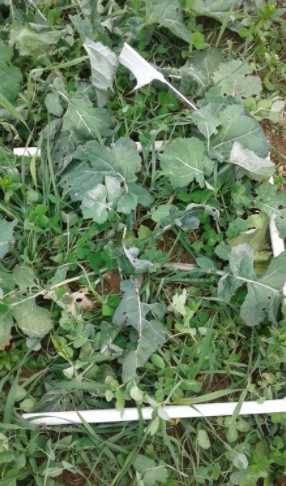By Jeff Mulhollem
Penn State researchers, in a recent study, were surprised to learn that they could take the exact same number of seeds from the same plants, put them in agricultural fields across the Mid-Atlantic region and get profoundly different stands of cover crops a few months later.
The study came to be known as “‘farm-tuning’ cover crop mixtures,” noted researcher Jason Kaye, professor of soil biogeochemistry, who added that the findings are significant because they show the need to customize cover crop mixes to achieve desired ecosystem services, depending on soil and climatic conditions.
Cover crop mixtures comprised of multiple species planted in rotation between cash crops provide a suite of benefits — such as erosion reduction, weed control, and adding carbon and nitrogen to the soil. But it turns out, the expression of species in a mixture can differ greatly across locations.

Two views of cover crops mixture research sites at Penn State's Russell E. Larson Agricultural Research Center. In the University’s experimental plots, researchers manipulated cover crop expression with nitrogen inputs and planting dates to learn response of the various species to soil conditions and growing days.
The study was novel due to its breadth and complexity. Researchers tracked a five-species cover crop mix planted over two growing seasons on eight organic dairy farms in Pennsylvania and New York and on research plots at Penn State’s Russell E. Larson Agricultural Research Center. In the University’s experimental plots, researchers manipulated cover crop expression with nitrogen inputs and planting dates to learn response of the various species to soil conditions and growing days.
“There have been very few studies like this — especially looking at cover crop mixtures that are comprised of more than two species — that analyze how species interact with each other, so I think it's important research,” Kaye said. “There has been a misguided assumption that you plant a cover crop mixture and you get the same result wherever you put it.”
Commercial seed companies sell many pre-formulated seed mixtures, but they can also make customized mixes, Kaye said. “Our results show that with fixed, preformulated mixtures, what you grow is not always what you expect.”
In the study, all eight of the participating farmers seeded the standard mixture and a “farm-tuned” mixture of the same five species — canola, Austrian winter pea, triticale, red clover and crimson clover — with seeding rates adjusted to achieve farmer-desired services. At each location, researchers parsed out the effects of soil inorganic nitrogen and growing days on cover crop mixture expression.

This closeup photo of the mix shows the five cover crop species — canola, Austrian winter pea, triticale, red clover and crimson clover.
When soil inorganic nitrogen and growing days were high, they found, canola dominated the mixture, especially in the fall.
From the same seed mixture, cover crop mixture expression varied greatly across farms, and researchers hypothesized that this variation was correlated with soil inorganic nitrogen concentrations and growing days, explained lead researcher Barbara Baraibar, who was a postdoctoral scholar in the Department of Plant Sciences when the study was conducted.
Kaye’s laboratory in the College of Agricultural Sciences has been conducting a continuous experiment evaluating the effectiveness of various cover crop mixtures since 2011.
In findings recently published in PLOS ONE, the researchers reported that low soil inorganic nitrogen favored legume species while a shorter growing season favored triticale. Changes in seeding rates influenced mixture composition in fall and spring but interacted with growing days to determine the final expression of the mixture.

Researcher Ebony Murrell, a postdoctoral scholar in the Department of Ecosystem Science and Management when the study was conducted, talks to farmers about the research during a field day.
The results show, Baraibar pointed out, that when soil inorganic nitrogen availability is high at the time of cover crop planting, highly competitive species can dominate mixtures, which could potentially decrease services provided by other species, especially legumes. And early planting dates can exacerbate the dominance of aggressive species.
Based on this study, farm managers should choose cover crop species and seeding rates according to their soil inorganic nitrogen and planting dates to ensure the provision of desired services, she advised, suggesting that the real value of this research is that it provides usable information to farmers who want to take advantage of it.
“We wanted to have an experiment that would be real enough for farmers to be able to use the data,” Baraibar said. “We wanted to know what actually happens when we plant these cover crop mixtures on many different farms that have different soils and different management. Our research paves the way for farmers and seed companies to use soil and climate knowledge to design custom seed mixes with predictable growth from the different species.”
Also involved in the research were Mary Barbercheck, professor of entomology; Charles White, assistant professor and extension specialist in soil fertility and nutrient management; David Mortensen, former professor of weed and applied plant ecology; Ebony Murrell, former postdoctoral scholar in the Department of Ecosystem Science and Management; and Brosi Bradley, field and lab technician in Kaye’s research group.
The U.S. Department of Agriculture’s National Institute of Food and Agriculture, Organic Research and Extension Initiative supported this work.

This is how the cover crop mix looked at one study site. From the same seed mixture, cover crop mixture expression varied greatly across farms and researchers hypothesized that this variation was correlated with soil inorganic nitrogen concentrations and growing days.
Source : psu.edu